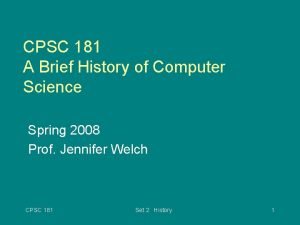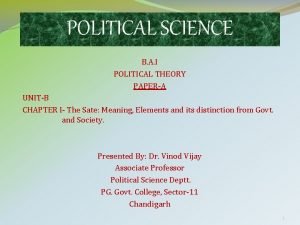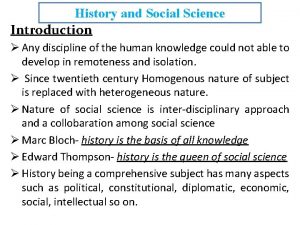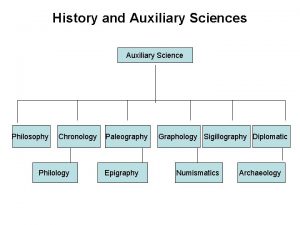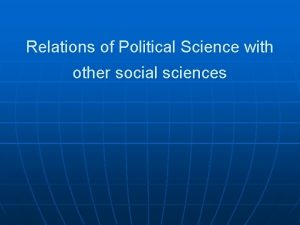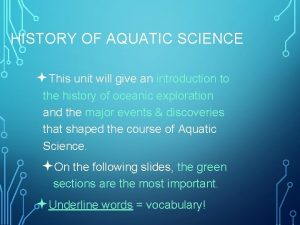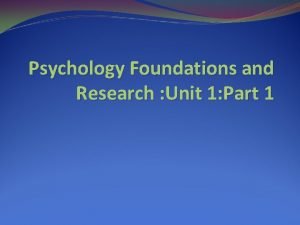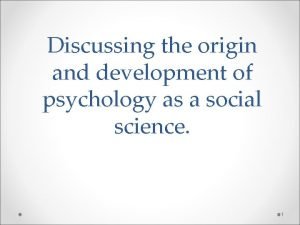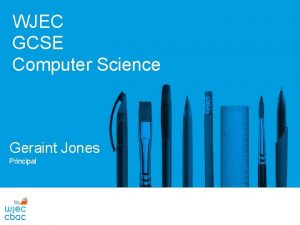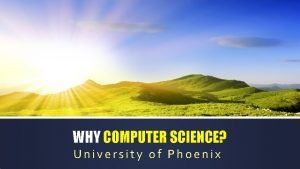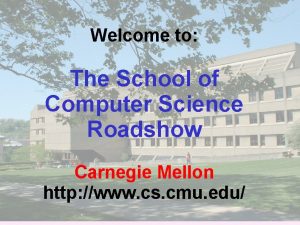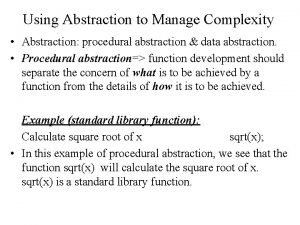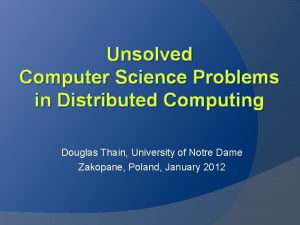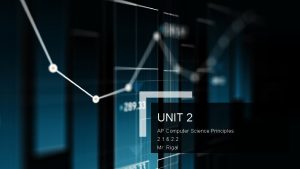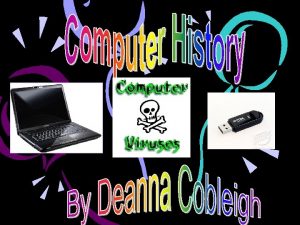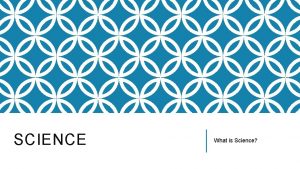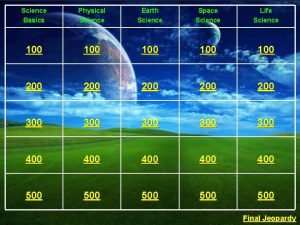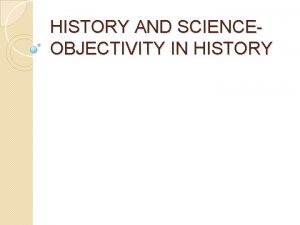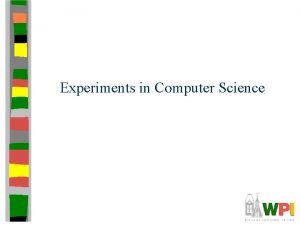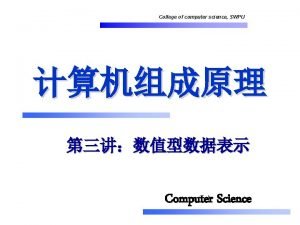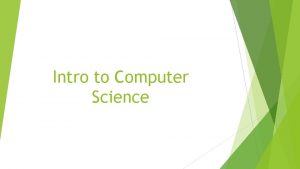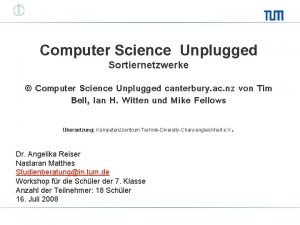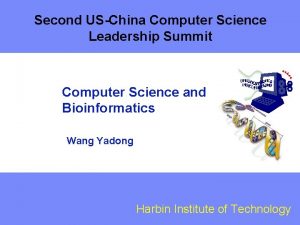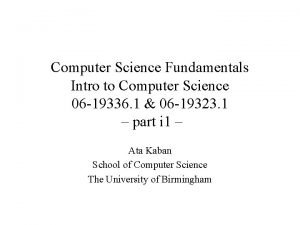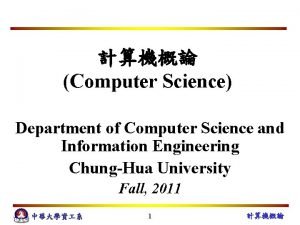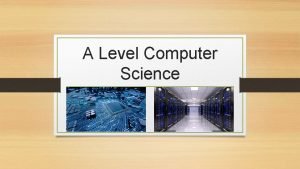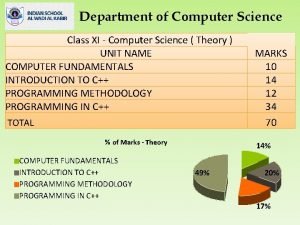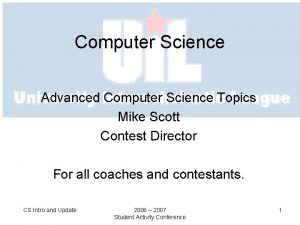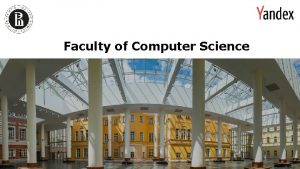THE HISTORY OF COMPUTER SCIENCE HISTORY OF COMPUTER







































































- Slides: 71

THE HISTORY OF COMPUTER SCIENCE

HISTORY OF COMPUTER SCIENCE

WHAT IS A COMPUTER?

EARLY COMPUTERS?



BLAISE PASCAL (APPROX. 1650) French Mathematician, theologian and scientist


BLAISE PASCAL (APPROX. 1650) Built a machine with 8 gears called the Pascaline to assist French government in compiling tax reports

PROGRAMMABLE MACHINES 1883 Music Box The ipods of their day?

PROGRAMMABLE MACHINES Vaucanson's mechanical duck

ROBOTS?

J. M. JACQUARD (EARLY 1800’S) developed loom that used punched cards (the equivalent of stored programs)

JACQUARD’S LOOM

PUNCHED CARDS information coded on cards (forerunner of modern storage devices) cards could be linked in a series (forerunner of programs) Such programs can automate human tasks

CHARLES BABBAGE British scientist and inventor, 1860’s known as ‘the Father of the Computer’

BABBAGE’S COMPUTER Difference Engine could compute and print tables, but never got out of the 'working prototype' stage because of technological limits

BABBAGE’S DREAM MACHINE The Analytical Engine steam powered calculating machine using programs on punched cards. The analytical engine was never completed in his lifetime.

ANALYTICAL ENGINE PLANS

ANALYTICAL ENGINE, CON’T Contained all the elements of moderncomputers including §'mill' (for calculating) §'store' (for holding instructions) §'operator' (for carrying out instructions) §reading and writing device

COUNTESS ADA AUGUSTA LOVELACE Lord Byron’s daughter Mathematician Devised way to use punched cards to give instructions to Babbage’s machines The ‘first computer programmer’

HERMAN HOLLERITH (1890 CENSUS) Invented a tabulating machine using punched cards (same size as ours today). Founded forerunner of IBM

HOLLERITH’S MACHINE

THOMAS WATSON, SR. (HEAD OF IBM IN 1924) Made his fortune in punched card tabulating equipment and office equipment Never convinced that computing machines were worth the risk. Turned over the company to his son in mid 1950’s

EARLY ELECTRONIC COMPUTERS Konrad Zuse § German engineering student, 1930’s § Never allowed to complete his computer ABC Computer § Atanasof and Berry § 1937 Mark I, Harvard, 1944 § Automatic calculator used paper tapes

THE ABC MACHINE 1937 The first electronic computer Dr. John V. Atanasof Clifford Berry

JOHN VON NEUMANN invented the stored program concept (data and instructions stored in memory in binary form). 1940's

COMPUTER SCIENCE HISTORY Alan Turing § WW II § Enigma § “Computers” John von Neumann § Programs as data ENIAC

ENIAC


GENESIS OF MODERN COMPUTING

HARDWARE “GENERATIONS” Hardware § vacuum tubes § transistors § printed circuits § integrated circuits Moore’s law § Circuit capacity doubles every 18 months § True from 1972 to the present day

THE FIRST GENERATION OF COMPUTERS 1951 -1958 Vacuum tubes for internal operations Magnetic drums for memory Limited memory Heat and maintenance problems

ENIAC (19, 000 VACUUM TUBES)

ENIAC MODULAR PROGRAMMING?

AGE OF THE DINOSAURS

1 ST GENERATION (CON’T) Punched cards for input and output Slow input, processing and output Low-level symbolic languages for programming

UNIVAC I (1951) developed by Mauchley and Eckert for Remington Rand replaced IBM tabulating machines at the Census Bureau

UNIVAC J. Presper Eckert and Walter Cronkite and the UNIVAC I on election night 1952

MACHINE LANGUAGE Machine language: 0's and 1's, the only language a computer can directly execute.

ASSEMBLY LANGUAGE Made programming easier. Uses abbreviations instead of binary code. ie. LD for load. Machine-dependent (not portable)

THE SECOND GENERATION OF COMPUTERS 1959 -1964 Transistors for internal operations Magnetic cores for memory Increased memory capacity

IBM 360

SECOND GENERATION (CON’T) Magnetic tapes and disks for storage Reductions in size and heat generation Increase in processing speed and reliability Increased use of high-level languages

HIGH-LEVEL LANGUAGES The first high-level programming languages were § FORTRAN (1954) § COBOL (1956) § LISP (1961) § BASIC (1964)

GRACE HOPPER 1952 She introduces the new concept that computers could be programmed using symbols on paper (languages). Later writes the COBOL language.

THE THIRD GENERATION OF COMPUTERS 1965 -1970 Integrated circuits on silicon chips for internal operations (IC’s) Increased memory capacity Common use of minicomputers

THIRD GENERATION (CON’T) Emergence of the software industry Reduction in size and cost Increase in speed and reliability Introduction of families of computers

KEY TERM: LSI (Large Scale Integration) - method by which circuits containing thousands of components are packed on a single chip

THIRD GENERATION (CON’T) Compatibility problems (languages, I/O devices, etc. were informally standardized) Minicomputers popular in offices.

THE FOURTH GENERATION OF COMPUTERS 1971 -today VLSI (100, 000's of components/chip) Development of the microprocessor Microcomputers and supercomputers Ted Hoff, Intel Designer of first microprocessor

4 TH GENERATION DESIGN

VLSI (EACH WAFER HAS 100 -400 IC’S WITH MILLIONS OF TRANSISTORS ON EACH ONE)

FOURTH GENERATION (CON’T) Greater software versatility Increase in speed, power and storage capacity Parallel processing Artificial intelligence and expert systems Robotics

GRAPHIC USER INTERFACES (GUI) Macintosh, 1984 Lisa, 1983 Sun, 1988

KEY TERM: MICROPROCESSOR Microprocessor: programmable unit on a single silicon chip, containing all essential CPU components (ALU, controller)

MODERN MICROPROCESSOR

KEY TERM: MICROCOMPUTER Microcomputer: small, low-priced, personal computer.

EARLY MICROCOMPUTERS Apple I, 1976 Apple II, 1977

APPLE COMPUTER COMPANY Steve Wozniak and Steve Jobs

EARLY IBM MICROCOMPUTERS IBM PC, 1981 IBM XT, 1983 w/10 M Hard drive

SOFTWARE GIANTS

PROGRAMMING LANGUAGE GIANTS Niklaus Wirth Pascal, 1972 BASIC, 1964 David Kennedy, Dartmouth U

KEY TERM: SUPERCOMPUTER Supercomputer: perform millions of operations per second and process enormous amounts of data Costs in tens of millions of dollars

SUPERCOMPUTERS (l to r) Cray xmp, ymp and Cray 2

CRAY T 90, 40 GIGAFLOPS

PROCESSOR SPEED GROWTH

ENVIRONMENT “GENERATIONS” Environments § single process § batch process § time-shared § one powerful computer serving multiple users § personal computer § multiple individual computers § client/server § individual computers (clients) interacting with powerful computer providing services to multiple users (server)

HARDWARE AND SOFTWARE

HARDWARE AND SOFTWARE

HARDWARE AND SOFTWARE
 Talk about your favorite subject at school
Talk about your favorite subject at school Continues on babbage programmable
Continues on babbage programmable Hát kết hợp bộ gõ cơ thể
Hát kết hợp bộ gõ cơ thể Frameset trong html5
Frameset trong html5 Bổ thể
Bổ thể Tỉ lệ cơ thể trẻ em
Tỉ lệ cơ thể trẻ em Chó sói
Chó sói Chụp tư thế worms-breton
Chụp tư thế worms-breton Hát lên người ơi
Hát lên người ơi Các môn thể thao bắt đầu bằng tiếng bóng
Các môn thể thao bắt đầu bằng tiếng bóng Thế nào là hệ số cao nhất
Thế nào là hệ số cao nhất Các châu lục và đại dương trên thế giới
Các châu lục và đại dương trên thế giới Cong thức tính động năng
Cong thức tính động năng Trời xanh đây là của chúng ta thể thơ
Trời xanh đây là của chúng ta thể thơ Mật thư anh em như thể tay chân
Mật thư anh em như thể tay chân Phép trừ bù
Phép trừ bù Phản ứng thế ankan
Phản ứng thế ankan Các châu lục và đại dương trên thế giới
Các châu lục và đại dương trên thế giới Thơ thất ngôn tứ tuyệt đường luật
Thơ thất ngôn tứ tuyệt đường luật Quá trình desamine hóa có thể tạo ra
Quá trình desamine hóa có thể tạo ra Một số thể thơ truyền thống
Một số thể thơ truyền thống Cái miệng bé xinh thế chỉ nói điều hay thôi
Cái miệng bé xinh thế chỉ nói điều hay thôi Vẽ hình chiếu vuông góc của vật thể sau
Vẽ hình chiếu vuông góc của vật thể sau Nguyên nhân của sự mỏi cơ sinh 8
Nguyên nhân của sự mỏi cơ sinh 8 đặc điểm cơ thể của người tối cổ
đặc điểm cơ thể của người tối cổ Thế nào là giọng cùng tên?
Thế nào là giọng cùng tên? Vẽ hình chiếu đứng bằng cạnh của vật thể
Vẽ hình chiếu đứng bằng cạnh của vật thể Phối cảnh
Phối cảnh Thẻ vin
Thẻ vin đại từ thay thế
đại từ thay thế điện thế nghỉ
điện thế nghỉ Tư thế ngồi viết
Tư thế ngồi viết Diễn thế sinh thái là
Diễn thế sinh thái là Dạng đột biến một nhiễm là
Dạng đột biến một nhiễm là Số nguyên là gì
Số nguyên là gì Tư thế ngồi viết
Tư thế ngồi viết Lời thề hippocrates
Lời thề hippocrates Thiếu nhi thế giới liên hoan
Thiếu nhi thế giới liên hoan ưu thế lai là gì
ưu thế lai là gì Sự nuôi và dạy con của hổ
Sự nuôi và dạy con của hổ Sự nuôi và dạy con của hươu
Sự nuôi và dạy con của hươu Sơ đồ cơ thể người
Sơ đồ cơ thể người Từ ngữ thể hiện lòng nhân hậu
Từ ngữ thể hiện lòng nhân hậu Thế nào là mạng điện lắp đặt kiểu nổi
Thế nào là mạng điện lắp đặt kiểu nổi Natural vs social science
Natural vs social science Brances of science
Brances of science Natural science vs physical science
Natural science vs physical science Applied science vs pure science
Applied science vs pure science Rapid change
Rapid change Extra credit
Extra credit Tragedy of the commons
Tragedy of the commons Windcube
Windcube Hard science and soft science
Hard science and soft science Political science and history relationship
Political science and history relationship What is history in social science discipline
What is history in social science discipline Examples of auxiliary sciences of history
Examples of auxiliary sciences of history Branches of forensic science ppt
Branches of forensic science ppt Economics and political science relationship
Economics and political science relationship Forensic science history timeline
Forensic science history timeline History of aquatic science
History of aquatic science Psychology definition
Psychology definition Introspection method in psychology
Introspection method in psychology History and origin of science of psychology slideshare
History and origin of science of psychology slideshare Gcse computer science wjec
Gcse computer science wjec Computer science university of phoenix
Computer science university of phoenix How many fields in computer science
How many fields in computer science What is procedural abstraction
What is procedural abstraction Computer science unsolved problems
Computer science unsolved problems Bridgeport engineering department
Bridgeport engineering department University of bridgeport engineering
University of bridgeport engineering Sequencing ap computer science principles
Sequencing ap computer science principles Ucl bsc computer science
Ucl bsc computer science

